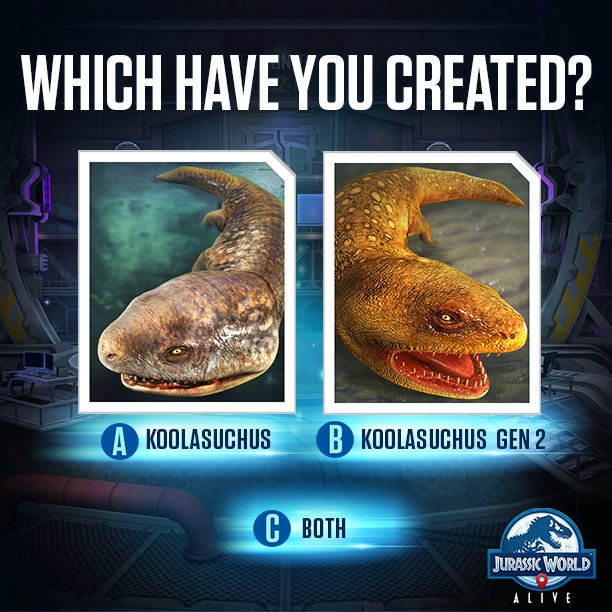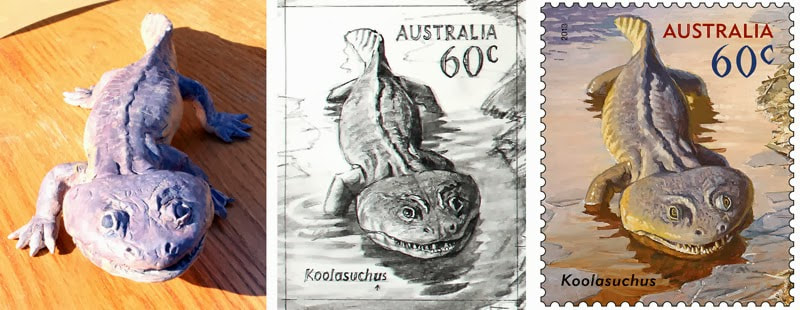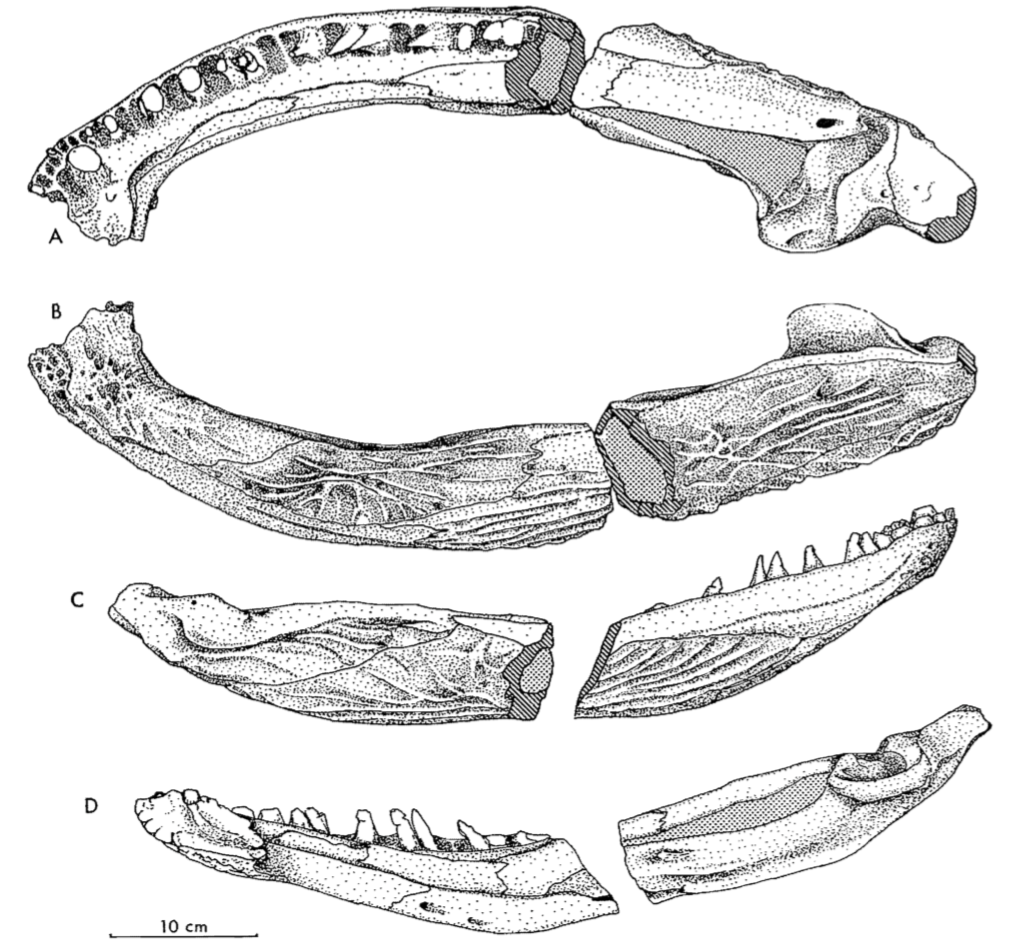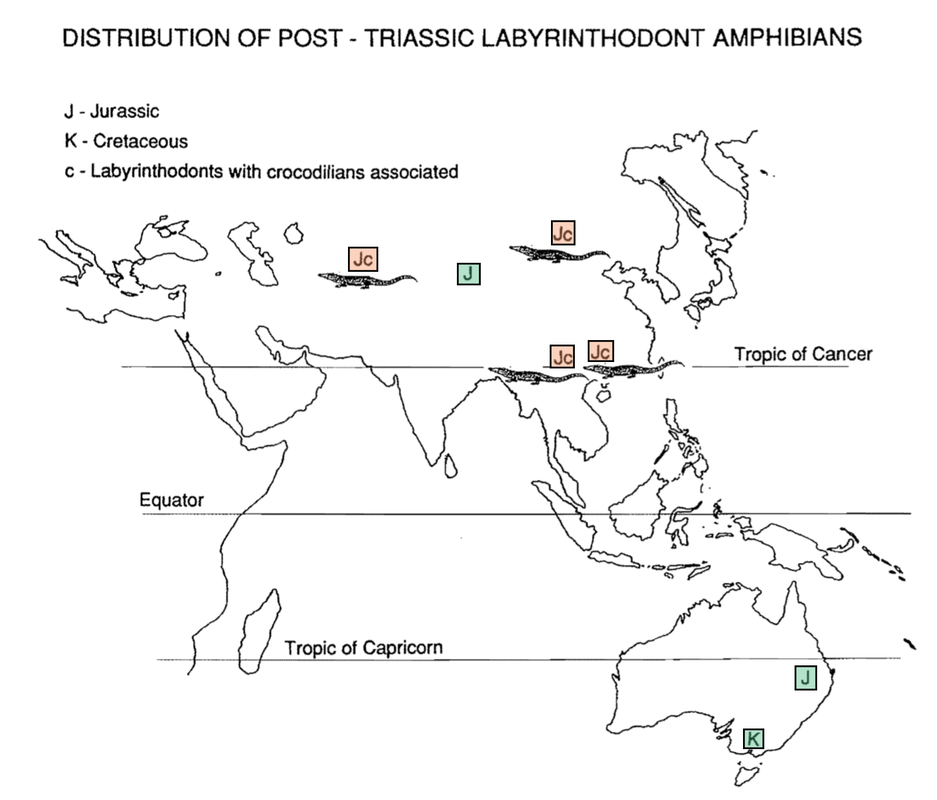|
Where are the temnospondyls today? Blasted off the face of the earth by an asteroid? Still lurking in some deep sea reservoir? Living out the cryptozoological lifestyle? No, no, and no. Notwithstanding various hypothesized relationships of temnospondyls to modern amphibians, the temnospondyls peter out after the Late Triassic. They make their last stand in the land down under, today a veritable hotbed of weird animals not found anywhere else. Koolasuchus cleelandi Koolasuchus is named for Lesley Kool, the primary preparator of the material, and Mike Cleeland, who found the holotype. The phonetically cool name ended up being a creative riff on the inferred 'cool' climate of Australia at the time (more on that below). Compared to other temnospondyls, Koolasuchus is a BIG-TIME *superstar.* It first appeared in the critically acclaimed documentary Walking with Dinosaurs (episode 5 if you want to get specific) just two years after being described. Unfortunately, most people don't know that this is a temnospondyl because the video title (the one from the official BBC account) calls it a 'giant crocodile'.... At least they call it an amphibian in the video, but it would surprise you how many people think that amphibians = reptiles.
In context Temnospondyls are a cosmopolitan group from basically when they show up all the way to the Triassic, stretching from pole to pole and across regions as wildly disparate today as Siberia, Texas, and Niger. Toward the end of the Triassic, they start going downhill, with only a few major groups left, and after the Triassic, all we're left with is a group known as the brachyopoids that includes Koolasuchus. Not only is this the only group left, they're only found in certain parts of the world, essentially Australia and Asia (+parts of Russia). This group was also more geographically extensive prior to the Jurassic, extending into the Americas, although brachyopoids are predominantly a southern hemisphere (Gondwanan) clade throughout their lengthy history. Brachypoids are not necessarily substantially larger than other Mesozoic temnospondyls - Koolasuchus is a bit of an outlier for the group - so size alone probably does not account for their persistence while other temnospondyls disappeared. Why Australia? The obvious question is what made prehistoric Australia so special that temnospondyls lasted so long down there? Modern-day Australia is a land of oddballs, particularly with respect marsupials, which are otherwise extremely rare, which it owes large in part to its geographic separation. But for much of its history, Australia has been physically joined with Antarctica and Africa before splintering off during the later part of the Mesozoic. The general hypothesis put forward is that Australia sat at a relatively high paleolatitude, as it does today, and would have been relatively cool during the Mesozoic, preventing the takeover of the region by crocodilians that are inferred to have extirpated temnospondyls in other regions of the world. At least some support for this may be derived from modern day patterns; the Asiatic giant salamanders, the largest living amphibians, are found in cold freshwater environments (they cannot handle hot temperatures) in which crocodiles are absent. Much of this hypothesis is predicated on traditional interpretations of temnospondyls, particularly the large stereospondyls, as having been similar in many respects (usually put in vague terms) to crocodilians. This idea has always been somewhat tenuous to me (here's me interjecting my opinion into my blog) because simply having a flat (sometimes) long skull and living in an aquatic environment does not automatically make one similar to a crocodilian. Many classic reconstructions of temnospondyls feature them sitting in the shallows basking and gaping or cruising at the top of the water column with their heads partially exposed as modern crocs do. The reality is that we often have no idea how temnospondyls hunted or where they swam. Most of them seem have thick bones that would have made sinking like a rock more feasible than actively swimming around, and they probably sat at the bottom of bodies of water waiting to ambush fish, a fundamentally different strategy from what most modern crocs practice. It's also unlikely that temnospondyls would have hauled onto land to bask because their lateral line systems (among other parts of their moist skin) would have been at risk for drying out. This isn't to say that this hypothesis should be thrown out. But it's important to note that in the Late Triassic, the not-particularly-crocodilian-looking metoposaurids do well with a group that can actually be inferred to be much more similar to crocodilians: phytosaurs (which look superficially very much like crocs but are only distantly related). In fact, virtually every locality in which a phytosaur has been found (there are a lot) has also produced a metoposaurid, so rather than competing, they apparently coexisted quite well with each other. By the time you get to the Jurassic, the only temnospondyls are brachyopoids, which have wide and short parabolic skulls, about the farthest you can get from a crocodilian skull shape within the temnospondyls. They also seem to coexist quite well with crocodilians of some flavour in the Jurassic in Asia and Russia. Therefore, competition isn't the only possible explanation; predation of more vulnerable larvae or climate change are others. Basically, we need more data. TLDR: I like blaming crocs for temnos' extinction, but there needs to be more testing, not just casual correlation, of this idea. Ref (yes there's only one)
Dann
3/28/2019 12:23:32 am
The Early Cretaceous deposits that contain labyrinthodont material in south-eastern Australia lack any evidence of crocodilians. Slightly younger deposits (c.10 million years later) contain croc remains - but no labyrinthodont material.
David Marjanović
4/1/2019 12:53:43 pm
I thought a crocodyliform fragment was found in the EK of southern Australia something like 10 or 15 years ago?
Dann
4/1/2019 06:00:56 pm
Croc fragments have been found at Dinosaur Cove (Otway Group), dating to the Albian. Koolasuchus is from the Strzelecki Group, which is slightly older (Aptian).
Andreas Johansson
3/28/2019 02:28:20 am
Is <i>Koolasuchus</i> the only known Cretaceous temnospondyl?
Bryan Gee
3/31/2019 10:54:27 pm
Hey Andreas,
Andreas Johansson
4/1/2019 12:47:23 am
Thank you Comments are closed.
|
About the blogA blog on all things temnospondyl written by someone who spends too much time thinking about them. Covers all aspects of temnospondyl paleobiology and ongoing research (not just mine). Categories
All
Archives
January 2024
|




 RSS Feed
RSS Feed
